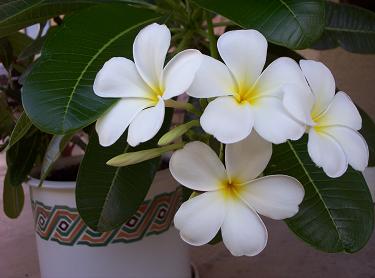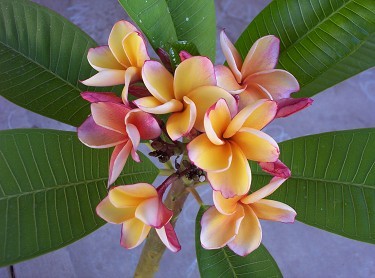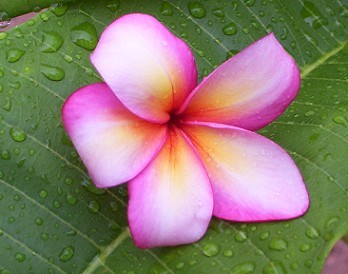|
 Photo
Photo
The plumeria on the right is a Singapore Obtusa. It was grown from a 2 foot
cutting purchased through the mail and was approximately 1.5 years
old at the time of this photo. It grew very quickly during warm weather
and is about 2 feet tall and 2.5 feet in diameter with three main branches. This plant spends
the year on a south facing covered patio where it receives sun most of the year and full
shade in mid-summer. It is brought inside when temperatures under 35 degrees F. are forecast.
The Singapore
Obtusa is famous for the scent of its flowers which can be found in many kinds
of perfumes.
Overview
Plumerias are a very popular plant because of their sweet smelling
colorful flowers and attractive form. In Hawaii, the plumeria
has become part of the culture and is used to make the lei necklaces
used in celebrations. Although they are thought of as tropical,
plumerias can handle a subtropical climate as long as temperatures don't go below freezing.
Some truly tropical plants get sick when temperatures are consistently cool, but plumerias are not one of them.
However, when it is cool out a plumeria should have its soil kept very very dry.
The branches can tolerate light frosts that happen above freezing but the leaves will be damaged.
Yes, you can get surface frosts even above freezing temperatures. Go search it up on the web. :)
In addition to the information given on this page, specific condensed instructions for caring for potted plumerias
in Phoenix can be found here Potted Plumerias.
 Plumerias can be divided into two main groups, the obtusa and the rubra. Obtusa
plumerias have rounded shiny leaves while the rubra have duller pointed leaves. Obtusa
plumeria generally have white flowers while rubra have colorful
flowers.
Plumerias can be divided into two main groups, the obtusa and the rubra. Obtusa
plumerias have rounded shiny leaves while the rubra have duller pointed leaves. Obtusa
plumeria generally have white flowers while rubra have colorful
flowers.
The plumeria on the left is a rubra named Penang Peach and has an amazing coco butter/cinnamon scent.
Plumerias generally start to flower in late spring and continue to flower all summer
holding their flowers in bouquets at the end of their stems. If you want your plumeria to flower by late May, it is important to get
it in full sun as early as possible, like at the beginning of March or earlier if the threat of frost has passed.
Temperatures over 100 Fahrenheit will cause the flowers to dry up prematurely so it is good to have your
tree located in a spot with afternoon shade.
Heat Tolerance and Sun Exposure
Obtusa plumerias will sun burn in the Arizona summer when subjected to full sun, so at the
least they should be placed where they will receive afternoon shade. The ideal
condition for an obtusa plumeria in Phoenix is filtered sun, such as under a tree with a
light canopy. In filtered sun it will get enough sun to bloom but will not be over exposed.
Rubra plumerias are slightly more heat tolerant than Obtusas. They can
take full Phoenix summer sun better but will still be more attractive with afternoon shade.
If moving a plumeria from shade to sun try to do so gradually. Like all plants, plumerias will burn if suddenly
moved from a low light to a high light environment.
Cold Tolerance
Plumerias go dormant when night time temperatures go below
50 degrees. Usually they will shed their leaves when going dormant but sometimes
they will just stop growing. Rubras lose their leaves more easily than obtusas do.
Plumerias should be not watered much at all when they are dormant. In fact, I think in
the middle of Winter my plants aren't watered for over a month.
Many references state that Plumerias cannot take temperatures below 40 degrees F.
Through experience, I have found this not to be the case.
In fact, I have a
rubra in my back yard, planted in the ground, that was subjected to temperatures
as low as 33 degrees F. (December 2003) without damage.
Furthermore, the potted Singapore Obtusa pictured above has experienced temperatures
as low as 35 degrees F. without incident. Even so, to play it safe I would recommend taking
some precautions to protect your plumeria if the temperatures are forecasted
to be below freezing. In the Phoenix area, this usually amounts to only a
handful of nights a year, although some parts of town are definitely warmer than
others. Before planting a plumeria in the ground, pay attention to how your
low temperatures compare to Sky Harbor's and put some thought into what parts
of your yard are more sheltered or warmer.
Planting in the ground
Dig a hole at least twice the size of the rootball. At a minimum, make the
hole 2 feet in diameter and 2 feet deep.
Back fill the whole with the same native soil that was removed.
It also is a good idea to finish with the
hole an inch or two recessed so that a watering basin is formed.
After planting, spread a thin layer of compost on top
of the soil to help conserve moisture and to supply some nutrients.
Do not fertilize the newly planted tree until it has been vigorously growing for
a couple of months.
Plumerias tend to have a flimsy foundation of roots when they are young,
especially if they are grown from a cutting, so it is good to tie them
to a strong wooden stake when planting.
Planting in a pot
Plumerias are trees, so they should be planted in the largest pot that
can be safely moved around. A light porous soil is best because it will
allow water to flow through and out of the base, which helps to reduce
the accumulation of salts present in Phoenix water, and will help keep the soil
from getting water logged. Aside from being frozen, being water logged is the
quickest way to kill a plumeria. A stake should be
used to prop up the plant until its roots have sufficiently anchored it.
This usually takes about a year. Most plumerias are grown from cuttings
and have flimsy anchorage until they are well established.
Watering frequency in the ground
Plumerias should be grown on a
citrus watering schedule.
Watering frequency in a pot
Plants in pots outside need a little more watering than those in the ground. In the
summer, a plumerias big leaves will facilitate evaporation so it
will need to be watered about once a week. In the
winter, a dormant plant should be kept very dry. A 100% dormant plant
does not need to be watered, while a plant that hasn't lost all
its leaves but is not really growing can be watered about once a month.
Watering method in the ground
Basin or flood irrigation
is recommended because it helps keep the salt in our salty
water from accumulating around the roots. Furthermore, deep watering
will encourage the plant to develop deeper roots, making the plant tougher when the weather
gets hot and dry.
Watering method in a pot
If the pot is outside, the plant can just be watered until water starts
pouring out the bottom. Obviously in the house this would make a mess,
so the plant can be watered until water starts to come through into the saucer.
However, if the plant is always kept in the house it is recommended to flush
water through the pot every now and then to reduce salt build up.
Fertilizing and Growth Rate
Plumerias grow rapidly and are therefore heavy feeders.
During the growing season, a plumeria can be fertilized every one to two months
using a high phosphate water soluble fertilizer. They should not be fertilized
during the cool time of the year when they are dormant or nearly dormant.
I currently use a combination of fish emulsion 0-10-10 and 5-1-1 to fertilize
my plumerias.
Pruning
Plumerias can be pruned to promote a desired shape. However,
they tend to branch less vigorously than your average plant, so
it is difficult to truly shape them. The good thing about their lack
of branching is that it results in thick branches and a fairly open canopy
which is part of what makes them look exotic. If one attempts to shape
a Plumeria they should keep in mind that branching habits are dependant
on the cultivar. For example, a Singapore Obtusa can be more easily trained
into a compact form than most Rubras. This makes the Obtusa a better potted
plant.
All types of Plumeria will branch at flowering points. Usually this results
in three branches. This is especially useful information for those new to
plumeria growing who are watching their new cutting go straight for
the ceiling as one slender stick. The temptation is to pinch the end to
promote branching. However, pinching the end in this case will inhibit the
emergence of flowers and possibly reduce branching overall. In fact, if the
Plumeria being pinched is a variety that likes to sprawl it will often just try to
send out a single new branch to continue in the direction it was growing before
it was pinched.
This behavior defeats the purpose for pinching it, and can
result in an uglier plant rather than the increase in attractiveness desired.
One can save themselves some frustration by researching what kind of growth
characteristics a plant has before purchasing it. Penang Peach is a really nicely
compact, frequently branching variety of Rubra.
Propagation
Plumerias are usually propagated by cutting and grafting. The links
below lead to very good sources on how to best do this.
Pests
Plumerias have no significant bug problems in Arizona. However, they can get black tip
rot when emerging from dormancy in the spring. Black tip turns all of the growing
tips black and also creates associated pockets of black liquid. This can kill the
plant if left to persist for a long time. However, it does result in the plant
branching, so if it's quickly cured it can actually have benefits.
In Phoenix, putting the plumeria in full sun cleans up black tip in a couple of
weeks or less. Full sun might not be an option in the middle of summer (see
heat tolerance above). Black tip is a fungus so the sun simply dries it out.
In humid climates this technique might not be as effective, so fungicides might be necessary.
Greenhouse white flies can be a problem with plumerias kept indoors. The type of white
fly that comes out in swarms in July in Phoenix appears to not bother plumerias at all.
I believe this is the citrus white fly. However, the green house variety will
multiply like crazy on your plant. The greenhouse variety does not live in AZ but
if you're unlucky you'll get it when you mail order a plant from somewhere more tropical,
like I did.
White flies are resistant to every pesticide known to man and are therefore almost impossible
to kill. The solution? Cut off all of your plants leaves, put them in a plastic bag and
soak them with pesticide and throw them in the trash. A healthy plumeria will survive this
but might decide to go dormant for a while before popping out leaves just to make you worry.
 Purchasing Plumerias
Purchasing Plumerias
I propagate plumerias and sell them on ebay and locally. Plants include
fresh cuttings, rooted cuttings, grafts, and larger juvenile trees. I do this as a hobby
so plants are not available all year. If you are interested in
purchasing one you can see what I currently have by clicking on the "Buy Plants"
link in the menu above.
More Photos of Plumerias Growing In the Phoenix Area
Here is an additional page showing Plumerias growing in the lower desert. If you
would like to contribute a picture to this page, please feel free to e-mail your
digital photo, along with an explanation of where you live, your plumeria variety,
and anything else you would like to add.
More Plumeria Photos
Links to more plumeria information
Plumerias at Florida Colors
|
 Book the Phoenix Tropicals Condo on Kiahuna Beach, in Kauai, Hawaii
Book the Phoenix Tropicals Condo on Kiahuna Beach, in Kauai, Hawaii